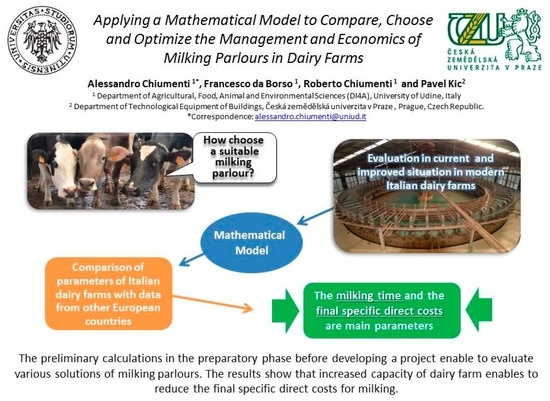2.1. Description of the Model
The first parameter taken into consideration is represented by the milking time. The advantage of reducing the duration of milking operation enables cows to have the opportunity to take feed and rest, to go grazing, and so on. The duration of a single effective milking of the entire herd can be derived from Equation (1).
where:
Tvd—the duration of one milking, min;
N—the number of lactating cows on the farm, cow;
QLS—the real capacity of a milking parlor, cow min
−1;
Tpr—duration time of working breaks, min.
As regards of a human working process and working operations, the total time of single milking, preparation, and subsequent work included, is determined by Equation (2).
where:
Tcd—total duration time of a single milking including preparatory operations and finishing work after milking, min;
Tp—the time of preparatory work before milking, min;
Tc—the time of finishing and cleaning work after milking, min.
When period Tcd is short enough, then there is enough time for workers (milkers) to carry out the other activities (feed preparation, cleaning, control of animals etc.). Therefore, the time should be a criterion for optimization and the selection of a suitable milking parlor for the farm.
The second decisive criterion should be the economic criteria. It is necessary to compare the specific data, which are in this case the final specific direct costs of a milking parlor per cow and year
uCMP, calculated according to Equation (3) as a sum of specific labor costs of milking per cow and year
uCW, specific costs of the milking equipment per cow and year
uCP including construction, and specific costs
uCS of supplies including the water, electricity, disinfectants etc. per one cow and year.
where:
uCMP—the final specific direct costs of milking parlor, EUR cow
−1 year
−1;
uCW—the specific labor costs per cow and year, EUR cow
−1 year
−1;
uCP—the specific costs of the milking equipment, EUR cow
−1 year
−1;
uCS—the specific costs of consumed supplies, EUR cow
−1 year
−1.
Specific labor costs
uCW are determined on the basis of labor requirements per cow per year T
r (h cow
−1 year
−1) obtained by using Equation (4) and average hourly wage of the milker. The labor requirement T
d can be used by Equation (5).
where:
Tr—the labor requirement for milking per cow per year, h cow
−1 year
−1;
Td—the milking labor requirement per cow per day, min cow
−1 day
−1.
where:
i—the number of milkings per day, day
−1;
trc—the average net labor requirement for milking per cow, min cow
−1;
tp—the time of preparatory work before milking per one cow, min cow
−1;
tc—the time of finishing and cleaning work after milking calculated per one cow, min cow
−1;
Tpr—duration time of working breaks, min.;
nds—the real number of milkers, pers.;
N—the number of lactating cows on the farm, cow.
Specific costs of the equipment uCP are evaluated as specific data of total operating costs of the machine per single cow. Therefore it includes the amortization of machinery, which is the purchase price of the machine expressed by percentage of machine amortization, further amortization of construction that includes construction costs and percentage of building amortization and the cost of servicing, maintenance, and repairs, which are usually expressed as a percentage of planned acquisition costs.
Specific costs of supplies uCS are determined as a sum of costs of all necessary operating materials and energy. The consumption of electricity is proportional to the power inputs of motors and all electrical appliances during their operation, water, disinfection etc. All is re-computed per cow and year (EUR cow−1 year−1).
The real number of milkers for the whole farm
nds is the rounded integer
nd. The theoretical required number of operators
nd is based on the calculation of Equation (6).
where:
nd—the theoretical required number of milkers per one parlor, pers.;
QPL—the required capacity of the milking parlor, cow min
−1;
Wd—the working capacity of one milker, cow min
−1.
The maximum reasonable number of operators per a parlor
ndm is a criterion to avoid the idle time or work complications. It is obtained by the number of milking stalls
mZ divided by the number of clusters
ns that can operate one milker.
where:
ndm—the maximum number of milkers per one parlor, pers.;
mZ—the number of milking stalls in milking parlor, pcs;
ns—the maximal number of clusters per milker, pcs.
An important technical parameter is the theoretical number of stalls in a parlor
mT, obtained by using Equation (8).
where:
mT—the theoretical number of milking stalls per parlor, pcs;
td—the average duration of milking by machine per one cow, min;
tv—the average idle time of a cluster, min.
where:
tn—the average time for cluster attachment, min;
ts—the average time to remove the cluster, min;
tm—the average time for manipulation with cluster, min.









